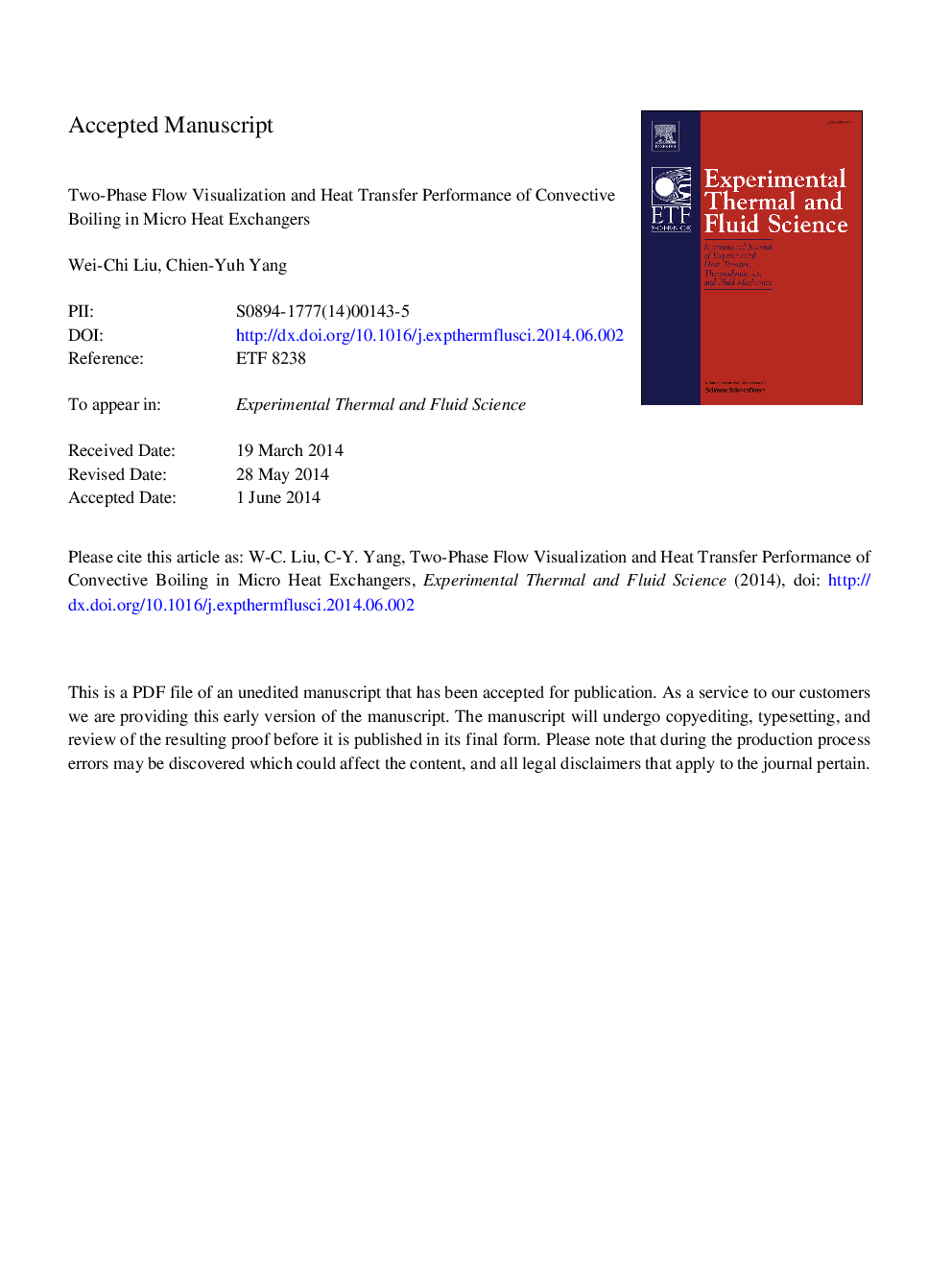| کد مقاله | کد نشریه | سال انتشار | مقاله انگلیسی | نسخه تمام متن |
|---|---|---|---|---|
| 651620 | 1457419 | 2014 | 22 صفحه PDF | دانلود رایگان |
عنوان انگلیسی مقاله ISI
Two-phase flow visualization and heat transfer performance of convective boiling in micro heat exchangers
ترجمه فارسی عنوان
تجسم جریان دو فاز و عملکرد انتقال حرارت جوش کنترلی در مبدل های گرمای گرم
دانلود مقاله + سفارش ترجمه
دانلود مقاله ISI انگلیسی
رایگان برای ایرانیان
کلمات کلیدی
مبدل حرارتی میکرو، جریان جوش، تجسم جریان، عبور جریان شونرون،
ترجمه چکیده
با توجه به ضریب انتقال حرارت بالا، خنک کننده تبخیری که شامل استفاده از مبدل های گرمای گرم می شود، یک راه حل مدیریت حرارتی برای خنک کننده دستگاه های الکترونیکی شار گرما است. تمایل به توسعه مبدلهای حرارتی با کارایی بالا که در رژیم تبخیر کار می کنند انگیزه اصلی برای کار حاضر را فراهم می کند. جریان انتقال گرما جوش در یک مبدل حرارتی میکرو با عبور جریان راست و چورون در این مطالعه مورد آزمایش قرار گرفت. الگوی جریان جوش نیز برای درک بیشتر مکانیسم های انتقال حرارت مشاهده شد. نتایج آزمون نشان می دهد که ضریب انتقال حرارت با افزایش جریان در هر دو مبدل حرارتی میکرو شونده و جریان مستقیم جریان افزایش می یابد. اما اثر شار حرارتی بر روی ضریب انتقال حرارت در مبدل حرارتی مستقیم در معرض خطر در مبدل حرارتی شویرون است. ضریب انتقال حرارت با افزایش شار حرارتی در مبدل حرارتی شویرون افزایش یافته است، اما در مبدل حرارتی مستقیم جریان کاهش می یابد. تجسم جریان از طریق مبدلهای حرارتی پوشش شفاف نشان می دهد که خشک شدن جزئی در جریان مستقیم مبدل های حرارتی در دمای پایین ترین میزان گرما اتفاق می افتد. این ناحیه انتقال حرارت ضعیفی را ایجاد کرده و عملکرد کلی انتقال حرارت را به طور قابل توجهی کاهش داد. نسبت بخشی نسبت خنثی جزئی و کسر زمان با افزایش شار گرما افزایش یافت و بنابراین ضریب انتقال حرارت با افزایش میزان گرما کاهش یافت. برای جوش جوش در مبدل حرارتی شفرون، فیلم مایع در گوشه تقاطع بین صفحات شفرون پانل بالا و پایین با نیروی کشش سطحی و مایع مایع دوباره به سطح گرما از دیگر جاده های شوانرون کشیده شد. هیچ خشک کردن جزئی مشاهده نشد و بنابراین نتایج آزمایش های انتقال حرارت به دنبال روند همبستگی های معمولی بود.
موضوعات مرتبط
مهندسی و علوم پایه
مهندسی شیمی
جریان سیال و فرایندهای انتقال
چکیده انگلیسی
Attributed to its high heat transfer coefficient, evaporating cooling involving the use of micro heat exchangers is considered a possible thermal management solution for cooling of high heat flux electronic devices. The desire to develop high-performance micro heat exchangers operating in the evaporation regime provides a major motivation for the present work. Flow boiling heat transfer in a micro heat exchanger with straight and chevron flow passages were tested in the present study. The boiling flow pattern was also observed for further understanding of the heat transfer mechanisms. The test results show that the heat transfer coefficient increased with increasing flow rate in both chevron and straight flow passages micro heat exchangers. But the effect of heat flux on the heat transfer coefficient in the straight passages heat exchanger is in adverse to that in the chevron passages heat exchanger. The heat transfer coefficient increased with increasing heat flux in the chevron passages heat exchanger but decreased in the straight passages heat exchanger. The flow visualization through transparent cover heat exchangers shows that partial dryout happened in the straight passages heat exchanger at the lowest heating rate condition. This caused a poor heat transfer area and significantly degraded the overall heat transfer performance. The partial dryout area ratio and time fraction increased with increasing heat flux and therefore the heat transfer coefficients decreased with increasing heating rate. For flow boiling in chevron passages heat exchanger, liquid film was dragged at the intersection corner between the upper and lower plate chevron passages by the surface tension force and supplement liquid flowed back into the heating surface from other chevron passages. No partial dryout was observed and therefore, the heat transfer performance test results followed the trend of conventional correlations.
ناشر
Database: Elsevier - ScienceDirect (ساینس دایرکت)
Journal: Experimental Thermal and Fluid Science - Volume 57, September 2014, Pages 358-364
Journal: Experimental Thermal and Fluid Science - Volume 57, September 2014, Pages 358-364
نویسندگان
Wei-Chi Liu, Chien-Yuh Yang,
